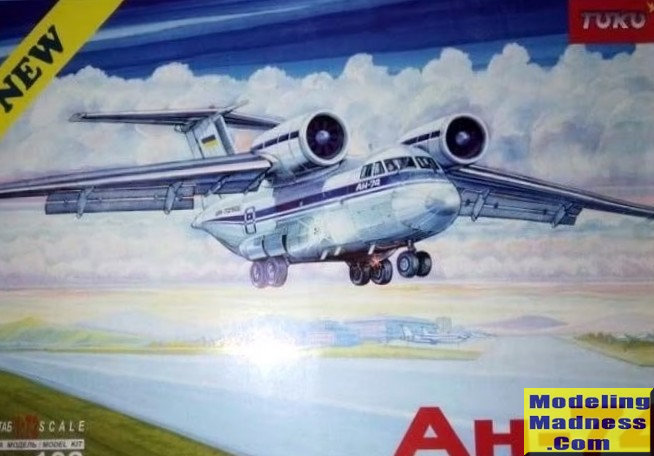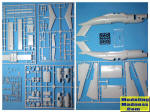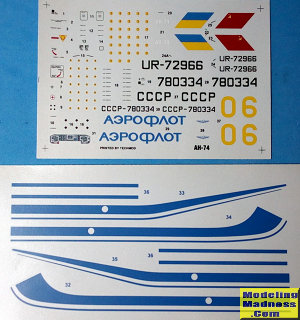
| KIT #: | 102 |
| PRICE: | €30 when new |
| DECALS: | Two options |
| REVIEWER: | Spiros Pendedekas |
| NOTES: |

| HISTORY |
The Antonov An-74 (NATO reporting name: Coaler) is a Soviet/Ukrainian transport aircraft developed by Antonov, featuring STOL flight characteristics. It is a variant of the An-72 and can be fitted with wheel-ski landing gear, de-icing equipment and a number of other upgrades allowing it to support operations in Arctic or Antarctic environments.
| THE KIT |
 Toko
is a Ukrainian model company which looks grossly affiliated with Roden. By
looking at the parts themselves, but also at the instructions layout, I would
place a safe bet that Toko evolved to Roden. The 1/72 Antonof 72/74 family of
kits hit the shelves in 1997, offered in one An-72 and two An-74 boxings. The
specific copy is the one of two An-74 versions.
Toko
is a Ukrainian model company which looks grossly affiliated with Roden. By
looking at the parts themselves, but also at the instructions layout, I would
place a safe bet that Toko evolved to Roden. The 1/72 Antonof 72/74 family of
kits hit the shelves in 1997, offered in one An-72 and two An-74 boxings. The
specific copy is the one of two An-74 versions.
The kit comes in a Roden-familiar good quality top opening box, featuring a nice
boxart of a Ukrainian An-74. Upon opening the box, I was greeted with a101 light
gray and 28 silver gray styrene parts. Of the 101 light gray parts, the fuselage
halves are provided separately, whereas the rest are arranged in 4 equally sized
big sprues. The silver-gray srue was a small one and contained somewhat more
“delicate” looking parts (like gear legs, antennas and turbine faces).
Panel lines are raised all over, something not that much expected, taking into
account the relatively “modern” 1997 kit origins, but otherwise looking
convincing. Molding is good with not too much flash, but I noticed a few sink
marks that will have to be addressed.
Cockpit is well appointed for the scale and the same can be said for the cargo
area. A decal is supposed to be affixed onto the instrument panel. The side
entry hatch and rear ramp can optionally be attached “open” The distinctive
engines are very well done, featuring molded-on details that can be viewable if
you decide to attach the separately given service panels in “open” position.
Landing gear looks good, with the main bays fully boxed but lacking any internal
detail. The tires are provided in rubber and, though looking nice, their
material might not be appealing to many modelers who (justifiably) believe that
rubber will eat the styrene rims over time. The ailerons and elevators are
separately given.
 Transparencies
are thick, but look well molded and clear. Instructions are nice, done in “Roden''
style, coming in the form of an 8-page A4 booklet, containing an extensive
history of the type, a parts list, with the somehow complex construction spread
in 41 clear steps. Color callouts are given during construction but not for all
items (one of them being, interestingly, the landing gear), so some research
will be ahead of you. Two schemes are provided, for a Ukrainian and an Aeroflot
bird. The thin Techmod decals are superbly printed and look to be in good
condition despite being 25 years old. Of note is that markings for a tactical
Ukrainian bird are included in the sheet (but the extra parts to represent it
are not included in the kit).
Transparencies
are thick, but look well molded and clear. Instructions are nice, done in “Roden''
style, coming in the form of an 8-page A4 booklet, containing an extensive
history of the type, a parts list, with the somehow complex construction spread
in 41 clear steps. Color callouts are given during construction but not for all
items (one of them being, interestingly, the landing gear), so some research
will be ahead of you. Two schemes are provided, for a Ukrainian and an Aeroflot
bird. The thin Techmod decals are superbly printed and look to be in good
condition despite being 25 years old. Of note is that markings for a tactical
Ukrainian bird are included in the sheet (but the extra parts to represent it
are not included in the kit).
Instructions want you to first assemble the cargo and cockpit areas, then trap
them between the fuselage halves. The main wing is next assembled, followed by
the engines that have to be attached on top of it. The horizontal stabilizer is
subsequently assembled and attached, followed by the wing/engines subassembly
and the front nose (the latter optionally in “open” position).
Last steps deal with landing gear assembly and installation, followed by
optionally mounted towing ramp and stepladder, ending a build of average
complexity. I could not find any weight suggestion, but I bet this model will be
a prime candidate for tail sitting, so you might consider adding some before
closing those fuselage halves (or, maybe, in the nose, should you go for a
“closed” nose position).
| CONCLUSIONS |
This looks to be a nice kit of this not too commonly seen but
nevertheless important plane. Overall shape looks correct, detailing is
sufficient for the scale, transparencies look good and the same can be said for
the decals.
The raised panel lines might not be too favorable for a number of modelers, but
will not bother many others and more or less look correct. Molding is good
without too much flash, but with a few sink marks to be attended. Rubber tires
look nice, but due to the media’s idiosyncrasies, it would have been preferable
to be provided in full styrene, at least as an option. Construction presents a
level of complexity, but otherwise looks straightforward.
As of 2022, this kit, together with its other two versions, can still be found
at quite reasonable prices. Interestingly, Eastern Express (and not Roden
itself) reboxed the kit family in 2007, but those kits are not that easy to
find.
Happy modeling!
July 2022
Copyright ModelingMadness.com. All rights reserved. No reproduction in part or in whole without express permission.
If you would like your product reviewed fairly and fairly quickly, please contact the editor or see other details in the Note to Contributors.